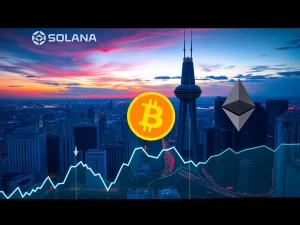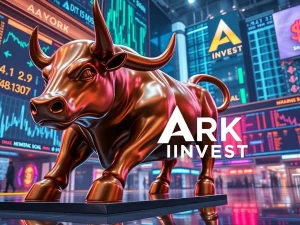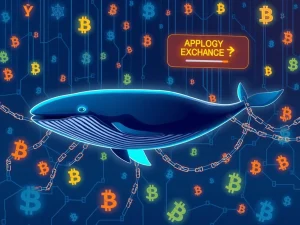Hyperliquid: Astonishing $330 Billion Trading Volume Achieved by Just 11 Employees

Imagine a financial powerhouse processing hundreds of billions in transactions each month, yet run by a team small enough to fit around a single conference table. This is the remarkable story of Hyperliquid, a DeFi exchange that has redefined what’s possible in decentralized finance. In July 2025, this lean operation achieved an astonishing $330 billion in monthly trading volume, a feat that briefly surpassed even established giants like Robinhood. How did just 11 employees manage such an incredible scale? This article delves into the innovative strategies and cutting-edge technology that propelled Hyperliquid to the forefront of the crypto market.
Hyperliquid’s Meteoric Rise in Trading Volume
Hyperliquid has rapidly emerged as a dominant force in decentralized finance. Indeed, its performance in July 2025 captured significant attention. The platform processed approximately $319 billion in perpetuals trading volume that month. This figure propelled DeFi-wide perpetuals to an unprecedented $487 billion. This marked a substantial 34% increase from June. Industry trackers reported a combined $330.8 billion, which included spot trading activity.
Consequently, headlines highlighted that Hyperliquid briefly surpassed Robinhood’s total volume. Robinhood’s July metrics showed $209.1 billion in equities notional and $16.8 billion in crypto trading. Including its subsidiary Bitstamp, Robinhood’s total reached around $237.8 billion. Several outlets noted that July was the third consecutive month Hyperliquid’s volumes outstripped Robinhood’s. This is a truly striking outcome for a team of only 11 individuals. These are monthly figures, not cumulative totals. Therefore, the platform demonstrates sustained, high-frequency activity, rather than just a one-off surge. This consistent performance underscores Hyperliquid’s growing influence.
The Core Architecture Powering Hyperliquid’s Decentralized Exchange
At its heart, Hyperliquid operates as a decentralized perpetuals exchange. It runs on a custom layer 1 blockchain. This chain features a unique split-chain design. It consists of two tightly integrated components. HyperCore manages the onchain order book, margining, liquidations, and clearing processes. In contrast, HyperEVM is a general-purpose smart contract layer. It interacts directly with the exchange state.
Both components rely on HyperBFT for security. This HotStuff-style Proof-of-Stake (PoS) consensus enforces a single transaction order. It does not depend on offchain systems. HyperEVM launched on mainnet on February 18, 2025. This addition brought programmability around the exchange core. Remarkably, Hyperliquid achieves a median trade latency of just 0.2 seconds. Even 99th-percentile delays remain under 0.9 seconds. It also handles up to 200,000 transactions per second. These speeds rival those of traditional centralized exchanges. The system’s design aims for low-latency finality. Crucially, it keeps both custody and execution entirely onchain. This architecture sets Hyperliquid apart as a formidable DeFi exchange.
Lean Operations and Strategic Independence Drive Hyperliquid’s Success
Hyperliquid’s operational model is intentionally lean. Founder Jeff Yan has stated that the core team comprises approximately 11 people. Hiring remains highly selective. This strategy helps maintain speed and cultural cohesion. The emphasis is on a small, coordinated group. It avoids rapid headcount expansion. Furthermore, the project is entirely self-funded. It has declined venture capital investment. Yan views this approach as aligning ownership directly with users. It also keeps priorities independent of investor timelines.
This self-funded model also explains the absence of major centralized-exchange listings. The focus remains squarely on technology and community adoption. Execution follows a tight feedback loop. For example, an API outage on July 29 disrupted order execution for 37 minutes. The team promptly reimbursed affected traders $1.99 million the very next business day. For a decentralized finance venue, this speed of response was exceptional. It exemplified their ‘ship, fix, own it’ mindset. Yan emphasized, ‘Hiring the wrong person is worse than not hiring at all.’ This selective hiring, independence from venture capital, and rapid incident management explain how a small team operates at a centralized-exchange cadence. They achieve this while keeping custody and execution fully onchain.
The HLP and Assistance Fund: Fueling Perpetual Trading Growth
Protocol mechanisms at Hyperliquid effectively align trader activity with liquidity provisioning. The Hyperliquidity Provider (HLP) vault plays a crucial role. HLP is a protocol-managed vault. It handles market-making and liquidations on HyperCore. Anyone can deposit capital into this vault. Contributors share in the vault’s profit and loss (PnL). They also receive a portion of trading fees. By making market-making infrastructure open and rules-based, HLP reduces reliance on bilateral market-maker deals. Such deals are common elsewhere in the market.
Furthermore, the Assistance Fund drives token buybacks. DefiLlama dashboards show that 93% of protocol fees flow into this fund. It buys back and burns HYPE tokens. The remaining 7% goes to HLP. This structure creates a powerful feedback loop. Higher organic trading volume fuels larger buybacks. This, in turn, reduces token supply. A portion still supports the HLP vault. Perpetual funding on Hyperliquid is purely peer-to-peer. There is no protocol take. Payments occur hourly. They are capped at 4% per hour. Rates combine a fixed interest (0.01% per eight hours, prorated hourly) with a variable premium. This premium derives from an oracle that aggregates centralized exchange spot prices. This structure helps keep perpetual prices aligned with spot. Payments are made by both sides of the book. This reinforces risk sharing without embedding yield promises. These mechanisms significantly boost perpetuals trading.
Strategic Distribution and Community-First Decentralized Finance
Hyperliquid’s token distribution strategy heavily favored its users. On November 29, 2024, the project launched the HYPE genesis airdrop. It distributed approximately 310 million tokens to early participants. This event coincided with the token’s trading debut. It strongly reinforced a community-first approach. HYPE is used for staking in HyperBFT. It also serves for gas payments onchain. Momentum accelerated significantly in mid-2025. This occurred when Phantom Wallet integrated Hyperliquid perpetuals directly in-app.
Analysts and media observed a clear boost in flow and adoption. VanEck’s July report attributed $2.66 billion in trading volume, $1.3 million in fees, and roughly 20,900 new users to the Phantom rollout. Separate reporting tracked $1.8 billion in routed volume within the first 16 days. On the product development side, HyperEVM went live on February 18, 2025. This enabled general-purpose smart contracts. It created pathways for wallets, vaults, and listing processes to integrate around the exchange. This flexibility encouraged outside developers to plug into the ecosystem. It also supported a steady pipeline of new markets. Notably, Hyperliquid’s genesis airdrop distributed around $1.6 billion worth of HYPE. This reached over 90,000 users. It equaled 31% of the total supply. At peak prices, the average airdrop value exceeded $100,000 per user. This demonstrated a strong commitment to its community and the broader decentralized finance ecosystem.
Critiques and Risk Factors for a Leading DeFi Exchange
Despite its impressive growth, Hyperliquid faces several critiques and risk factors. In early 2025, researchers and validators raised concerns. They questioned validator transparency and potential centralization. The team acknowledged these issues. They stated they would open-source the code after strengthening its security. The team also outlined plans to expand validator participation. This aims to enhance decentralization.
Concentration risk also poses a challenge. Hyperliquid’s market share is often estimated at 75%-80% of decentralized perpetuals trading. Commentators highlight the benefits of network effects. However, they also note the systemic risks. These risks arise if liquidity shifts or shocks occur at a single venue. Operational incidents are another concern. The 37-minute API outage on July 29 temporarily halted trading. Hyperliquid reimbursed approximately $2 million to users the next day. While this swift refund reinforced its reputation for responsiveness, the event also highlighted the exposure leveraged traders face during outages. Furthermore, observers sometimes scrutinize governance and treasury execution. This includes how protocol-managed vaults allocate capital offchain or across chains. The design of buyback mechanisms also draws attention. These remain areas of operational risk to watch as this prominent DeFi exchange scales. It is worth noting that Hyperliquid depends on validator-maintained price oracles. Manipulation of these oracles could trigger premature or inaccurate liquidations. To counter this, Hyperliquid limits open interest levels. It also blocks orders more than 1% away from the oracle price. However, the HLP vault is exempt from these specific restrictions.
Why Hyperliquid Thrives Where Others Struggle in Decentralized Finance
Four primary factors explain Hyperliquid’s exceptional growth. First, its execution-first chain design is paramount. HyperCore handles onchain matching and margin. Meanwhile, HyperEVM provides composability. Both operate under HyperBFT. This setup delivers near centralized-exchange latency. Crucially, it keeps custody and state fully onchain. Second, incentive alignment has been key. Fee-funded buybacks, via the Assistance Fund, and the open HLP vault created a reflexive liquidity loop. This expanded as trading volume grew.
Third, maintaining a lean core team of about 11 contributors minimized managerial overhead. It also kept product cycles remarkably fast. Fourth, distribution advantages proved significant. Most notably, Phantom Wallet’s integration reduced onboarding friction. It expanded reach during a favorable cycle for onchain derivatives. For those evaluating long-term durability, several watchpoints remain crucial. These include whether validator decentralization and code open-sourcing progress as promised. Observers also watch how quickly spot markets, central limit order book activity, and third-party apps build around HyperEVM. Finally, whether revenue and volume remain resilient as competitors adopt similar models is vital. Hyperliquid’s journey offers valuable insights into building a successful decentralized finance platform.








